Malva verticillata
| Malva verticillata | |
|---|---|
.jpg) | |
| Illustration of the leaves and seeds of M. verticillata | |
| Scientific classification | |
| Kingdom: | Plantae |
| Clade: | Angiosperms |
| Clade: | Eudicots |
| Clade: | Rosids |
| Order: | Malvales |
| Family: | Malvaceae |
| Genus: | Malva |
| Species: | M. verticillata |
| Binomial name | |
| Malva verticillata | |
Malva verticillata, also known as the Chinese mallow[1] or cluster mallow,[2] is a species of the mallow genus Malva in the family of Malvaceae found in East Asia. M. verticillata is an annual or biennial that grow up to 1.7 meters in high and can inhabit woodland areas of different soil types. In temperate climates, it flowers from July to September and the seeds from August to October. The flowers of the plant are self-fertile but can also be pollinated by insects.[3]
The plant was an important leaf vegetable in pre-Han China and widely cultivated.[4] Mallow is mentioned in Huangdi Neijing as one of the five consumable herbs (五菜) which included mallow (葵), pea leaves (藿), Allium macrostemon (薤), Welsh onion (蔥) and Garlic chives (韭).[5] It was deemed to be a major vegetable until the Northern Wei, supposedly. The technology for domesticating mallow was well recorded in Qimin Yaoshu. The acreages were dwindled since the Tang dynasty. In his Nong Shu [Agricultural Manual], Wang Zhen wrote that mallow came top among various vegetables, because "it could be alternative in years of crop failure, or be marinated to serve with staples". There were rare occasions that people cultivate or consume mallow, during the Ming dynasty.[6]

References
- ↑ "BSBI List 2007". Botanical Society of Britain and Ireland. Archived from the original (xls) on 25 January 2015. Retrieved 2014-10-17.
- ↑ "Malva verticillata". Natural Resources Conservation Service PLANTS Database. USDA. Retrieved 27 January 2016.
- ↑ Malva verticillata - L., Plants For A Future,
- ↑ Anderson, Eugene N. (1988), The Food of China, Yale University Press
- ↑ 古代五菜, 2010-03-04
- ↑ Wu, Cunhao (1996). 中国农业史 [A History of Chinese Agriculture]. p. 410. ISBN 9787810276962.